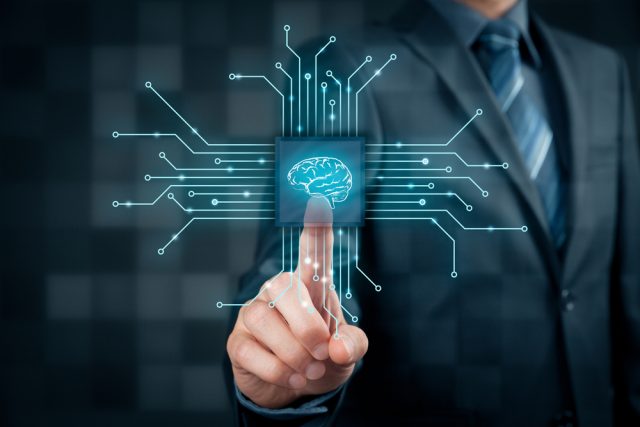Digital transformation depends on diversity

Diversity of skills, perspectives, experiences and geographies has played a key
role in our digital transformation. At Levi Strauss & Co., our growing
strategy and AI team doesn’t include solely data and machine learning scientists
and engineers. We recently tapped employees from across the organization around
the world and deliberately set out to train people with no previous experience
in coding or statistics. We took people in retail operations, distribution
centers and warehouses, and design and planning and put them through our
first-ever machine learning bootcamp, building on their expert retail skills and
supercharging them with coding and statistics. We did not limit the required
backgrounds; we simply looked for people who were curious problem solvers,
analytical by nature and persistent to look for various ways of approaching
business issues. The combination of existing expert retail skills and added
machine learning knowledge meant employees who graduated from the program now
have meaningful new perspectives on top of their business value.
The hottest hyper-automation trends disrupting business today

The global pandemic has highlighted a need for more flexible customer service,
using digital channels, as well as the possibility of organisations delivering
service without being tied down to a particular location. Both factors have
driven increased adoption of hyper-automation, and have led to more
differentiation in customer service joining the biggest trends in the space.
According to Luis Huerta, vice-president and intelligent automation practice
head, Europe at Firstsource, “as fixed-schedule, routine, processes and tasks
are automated in the back-office, the need for staff to be tied to a specific
location diminishes. Furthermore, with hyper-automation, the role of human
colleagues switches from hands-on task execution to managing and monitoring
bots, and dealing with complex business exceptions. ... As end customers
are increasingly able to leverage automated channels to solve their needs, the
pressure on support staff reduces and we give front-line colleagues an ability
to focus on complex enquiries where a human touch is critical.
How Drife and blockchain are disrupting the ride-sharing industry

Blockchain technology offers a way to make life and work easier, regardless of
the industry or class, and the ride-sharing industry is one a lot of disruptors
and companies in the blockchain space are looking to become major players in.
There have been a lot of bold claims about giving drivers and users more freedom
through the use of decentralized technology such as that of the blockchain. One
of the companies that made this claim is Drife. Drife is a decentralized
ride-sharing and peer-to-peer ride-sharing platform that was started with the
intent of empowering the drivers and riders within its ecosystem. The app is
built on the Aeternity blockchain and its business model is built on taking zero
commission from its drivers. Drife will instead charge drivers an annual fee on
its platform to access the app. “We believe when there’s a driver who spends 14
to 16 hours behind the wheel, he deserves to take back all the income to his
home,” said Sheikh. ... While Uber, Lyft and others were formed with good
intentions, they have become centralized, continuously paying their drivers less
and charging their riders more.
AI Wrote Better Phishing Emails Than Humans in a Recent Test

Researchers have long debated whether it would be worth the effort for scammers
to train machine learning algorithms that could then generate compelling
phishing messages. Mass phishing messages are simple and formulaic, after all,
and are already highly effective. Highly targeted and tailored “spearphishing”
messages are more labor intensive to compose, though. That's where NLP may come
in surprisingly handy. At the Black Hat and Defcon security conferences in Las
Vegas this week, a team from Singapore's Government Technology Agency presented
a recent experiment in which they sent targeted phishing emails they crafted
themselves and others generated by an AI-as-a-service platform to 200 of their
colleagues. Both messages contained links that were not actually malicious but
simply reported back clickthrough rates to the researchers. They were surprised
to find that more people clicked the links in the AI-generated messages than the
human-written ones—by a significant margin. “Researchers have pointed out that
AI requires some level of expertise. It takes millions of dollars to train a
really good model,” says Eugene Lim
Data warehousing has problems. A data mesh could be the solution

Simply stated, a data mesh invests ownership of data in the people who create
it. They’re responsible for ensuring quality and relevance and for exposing data
to others in the organization who might want to use it. A consistent and
organization-wide set of definitions and governance standards ensures
consistency, and an overarching metadata layer lets others find what they need.
“Data mesh is the concept of data-aligned data products,” Dehghani said in a
video introduction. “Find the analytical data each part of the organization can
share.” Dehghani lists eight attributes of a data mesh. Elements must be
discoverable, understandable, addressable, secure, interoperable, trustworthy
and natively accessible and they must have value on their own. The concept of
decentralized data management is nothing new. Distributed databases rode the
coattails of the client/server craze in the 1990s. Part of the appeal of the
Hadoop software library of a decade ago was that processing was distributed to
where data lived.
Why AI isn't the only answer to cybersecurity [Q&A]

The battle between an attacker and the defenders is exactly the reason where the
human factor comes into play and AI helps those defenders to focus and make
decisions that optimize their time and skills. What we're seeing today is basic
technology that’s designed for very specific attacks. It's only in 0.1 percent
of attacks that very sophisticated technology is being used. There are millions
of attacks every day, so you'll see advanced techniques; whereas, nine million
other attacks are happening that are just super rudimentary, garden variety
ransomware attacks and viruses. The latter are the mass of the attacks, and
they're also the mass of the damage. If you're a nuclear reactor, then
somebody's going to do massive harm, but if you're an average SMB, then you're a
lot more susceptible to those garden variety attacks that we call drive-bys.
Those machines aren't cutting edge and those attacks aren’t either. They're just
the common things that have been learned over the past few years. However, with
the forefront of attacks and premium ATPs, it'll be a battle of wits between the
advanced technology versus their technology.
When Will Quantum Computing Finally Become Real?

It's important to remember that quantum computers aren't just faster computers,
but harbingers of an entirely new type of computation. “If realized in the best
possible way imaginable, they would fundamentally change the world as we know
it,” says Tom Halverson, a staff quantum scientist on the quantum computing team
at management and information technology consulting firm Booz Allen Hamilton.
“Because of this, many powerful forces are positioning themselves to be ‘the
first,’” he states. “When the quantum computing revolution happens, it will
happen quickly.” Quantum computing is already real, but it's simply not yet
practical, observes Mario Milicevic, an IEEE member and a staff communication
systems engineer at MaxLinear, a broadband communications semiconductor products
firm. He notes that IT leaders will need to understand whether a quantum
computer is the appropriate tool for the type of problem their organization is
trying to solve. “For the majority of problems, classical computers will
actually outperform quantum computers and do so at a much lower cost,” Milicevic
states.
New connections between quantum computing and machine learning in computational chemistry

A quantum computer, integrated with our new neural-network estimator, combines
the advantages of the two approaches. A quantum computer, integrated with our
new neural-network estimator, combines the advantages of the two approaches.
While a quantum circuit of choice is being executed, we exploit the power of
quantum computers to interfere states over an exponentially-growing Hilbert
space. After the quantum interference process has worked its course, we obtain a
finite collection of measurements. Then a classical tool—the neural network—can
use this limited amount of data to still efficiently represent partial
information of a quantum state, such as its simulated energy. This handing of
data from a quantum processor to a classical network leaves us with the big
question: How good are neural networks at capturing the quantum correlations of
a finite measurement dataset, generated sampling molecular wave
functions? To answer this question, we had to think about how neural
network could emulate fermionic matter. Neural networks had been used so far for
the simulation of spin lattice and continuous-space problems.
The obstacles VR will overcome to go mainstream for business users

The truth is that VR is not far off becoming an essential tool for helping
businesses to become smarter and more efficient in the way they train staff.
For example, vocational training provider Mimbus uses VR training for a range
of skills including carpentry, construction, decorating, electrical
engineering, and food processing. Working with HP VR hardware, the immersive
nature of VR removes the pressures of getting things wrong in real life and
increases confidence when it comes to performing skills on the job. This
solution can help businesses significantly cut training costs. VR can also
help businesses to communicate with clients and design new products and
services. In fact, in a sales and marketing capacity, studies have shown that
customers have a 25% higher level of focus when in a virtual space, showing
that VR is a great way to capture customers’ attention. Alongside biosensors
and AI, VR could be used in the future to test how drivers feel about a new
car interior before it has been built, or improve the outcome of virtual
meetings and collaboration by capturing the nonverbal cues of
participants.
Disentangling AI, Machine Learning, and Deep Learning
Expert systems were proving to be brittle and costly, setting the stage for
disappointment, but at the same time learning-based AI was rising to
prominence, and many researchers began to flock to this area. Their focus on
machine learning included neural networks, as well as a wide variety of other
algorithms and models like support vector machines, clustering algorithms, and
regression models. The turning over of the 1980s into the 1990s is regarded by
some as the second AI winter, and indeed hundreds of AI companies and
divisions shut down during this time. Many of these companies were engaged in
building what was at the time high-performance computing (HPC), and their
closing down was indicative of the important role Moore’s law would play in AI
progress. Deep Blue, the chess champion system developed by IBM in the later
1990s, wasn’t powered by a better expert system, but rather a compute-enabled
alpha-beta search. Why pay a premium for a specialized Lisp machine when you
can get the same performance from a consumer desktop?
Quote for the day:
"Leaders must be good listeners. It_s
rule number one, and it_s the most powerful thing they can do to build
trusted relationships." -- Lee Ellis
No comments:
Post a Comment